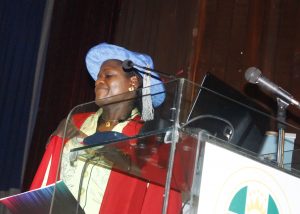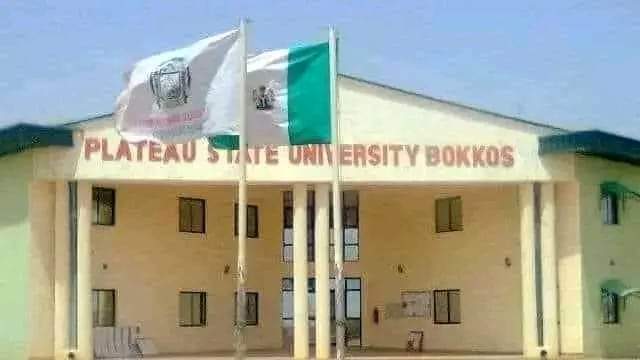19th March, 2014 was the date. 4:00pm was the time. With the university Main Auditorium full to capacity, Professor (Mrs.) Grace Olapeju Otinwa was the scholar of the evening. She delivered the session’s first Inaugural lecture on the topic “One Cause, Many Crises: The Kinetic Interpretation of Wellness”.
The Professor of Exercise Physiology reminded her teeming audience, the lecture was the 256th Inaugural Lecture of the University of Lagos; the 24th in the Faculty of Education, the 3rd in the Department of Human Kinetics and Health Education, the first in Exercise Physiology and the very first in Year Two Thousand and Fourteen.
The erudite scholar lecture was structure into six parts as follows;
- Epidemiological transition to physical inactivity
- Fat pattern and epidemic of obesity
- Consequences of physical inactivity
- The role of exercise in the prevention and treatment of diseases
- Principles of exercise prescription and
- Economic and Psychological cost of physical inactivity.
In her introduction, she informed the structure of the human body as designed by God and defined by Exercise Physiologists comprises: (1) fat-free weight-which is made up of bones, muscles, skin, blood and organs and (2) the fat weight, which consists of stored and essential fats. These components of the human anatomy function well when food ingested converts potential chemical energy derived from it into chemical and heat energy. If the amount of energy intake equals the amount of energy expended, the body is in a state of energy balance and weight remains stable. This biological nature of human beings has made it necessary for people to engage in one form of physical activity or another, from birth to death. However, if excess food is ingested, the extra energy derived is not lost but is stored as fat; this leads to weight gain, which often leads to energy imbalance and results in systemic malfunction.
One Cause – Epidemiological Transition to Physical Inactivity
The primordial forms of physical activity have been changing from primitive times to the advent of civilization and technology. These changes she lectured have been classified into three stages; The Pre-Agrarian Era, The Agrarian Era and The Post-Agrarian Era.
Fat Patterning and Obesity
Energy Equation and Body Weight: Energy balance has been a central selective force throughout human evolutionary history. Obtaining dietary energy and nutrients from the environment traditionally required an expenditure of somatic energy through human movement. Energy balance is the integrated effects of diets, physical activity, and genetics on growth and body weight over and individual’s lifetime.
Energy intake (E in) from food nutrients is provided by proteins, carbohydrates and fats; the highest caloric supply comes from fat. Energy Output (E out) represents the total energy expenditure, which comprises basal metabolic late (BMR), physical activity and the thermic effect of blood.
Fat Patterning
Fat storage varies among individuals. In general, fat distribution is in three basic patterns: android, gynoid and intermediate patterns. All these patterns can be found in males and females, although there is a self-specific dominant associated with android and gynoid patterns.
Global Status of Overweight and Obesity
The immediate effects of inadequate physical activity are overweight and obesity. These conditions are increasing at an alarming rate throughout the world. The increasing prevalence of overweight and obesity across the globe has aptly been described as the obesity epidemic. Today it is estimated that there are more than 300million obese people worldwide, affecting men, women, and children. Many countries have experienced a startling increase in obesity rates over the last 10-20 years. Over the past decade obesity levels have increase on an average of 10-40%.
The Relationship between Exercise, Body Fat and Body Weight
Regular physical activity positively affects lipid metabolism and lipid profiles Aerobic physical activities utilize the oxygen energy systems that require thr mobilization and metabolism of the body’s fat storage. Exercise training helps the body manage cholesterol level more effectively. Cross-sectional comparison of lipid profiles in physical active and sedentary women suggest that physical fitness is inversely related to the total cholesterol. Exercise reduces total body fat. Aerobic physical activities utilize the oxygen energy systems that require the mobilization and metabolism of the body’s fat storage. Weight-resistance activities help stimulate muscular development, preventing significant losses of lean body tissue that generally occur during calorie-restricting diets. Exercise training helps the body manage cholesterol levels more effectively.

The immediate function of physical activity in an exercise programme is simply to increase the level of energy expenditure. This helps to unbalance the caloric equation so that there is a greater amount of energy output. Exercises increases strength, posture, balance and decreases falls and their resultant fractures. Physical activity also helps people maintain appropriate body weight. It improves appearance and decreases waistline. Physical activity increases the metabolic rate both during activity and afterwards. To some degree, regular physical activity appears to contribute to the normal functioning of the brain’s feeding control mechanism. A sensitive balance between energy expenditure and good intake of such is apparently not very well maintained in physically inactive people. Individuals who are physically active are better able to match daily energy intake with daily expenditure.
Challenging Barriers to Physical Activity and Changing Needs
Physical inactivity is fueled by several factors. From her interaction with people of different age brackets and research studies conducted among different population groups, she posited the most common challenges cited for not engaging in regular exercise, in order of significance, are as follows:
- Lack of time
- Cultural Factors
- Social and Environmental Factors
- Psychological Factors
- History of Previous Injury
- Educational and Economic Factors
In her lecture’s conclusion, she married religion with scholarship and recommended “the bible says wisdom is better than the weapons of war (Ecclesiastes 9.18) and physical exercise has some value (1Timothy 4:8). Considering the numerous benefits of living an active lifestyle, it is therefore wise to embrace exercise option when compared with the experience of pain from diseases; as well as the ingestion of drugs and its side effects. Her recommendations she backed are based on the fact that physical activity has suffered from paradigm shift in individuals, the university, professionals in Human Kinetics, Health, Recreation, Sports, and Dance, Federal and State Interventions and Network of Stakeholders.
P.S: All contents of this article remain the copyright of OTINWA, Grace Olapeju. The full lecture can be purchase in the department of Human Kinetics Education or at the University of Lagos bookshop.









